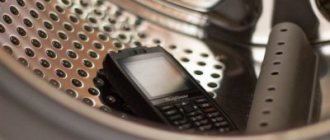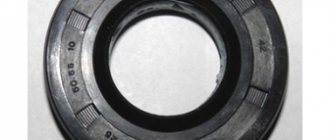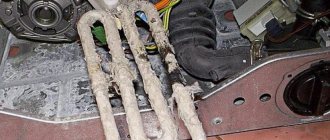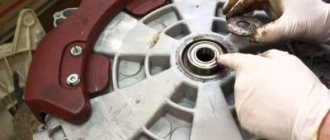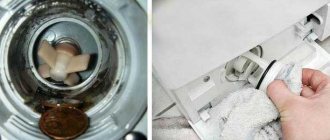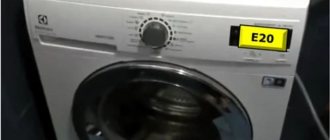During the delivery of household appliances from the manufacturer to the point of sale, and then to the consumer, it is necessary to ensure its safety. For this purpose, a cardboard box with a foam frame is most often used, but such protection is not always enough. Transport bolts on the washing machine are needed so that during transportation of the unit the drum does not damage its internal parts and does not become deformed.
Where are the shipping bolts located?
The washing machine differs from other devices in that it has a freely moving internal part - a tank with a drum. This is the heaviest part of the unit. It is suspended on powerful springs from the inside of its body, and rests on shock absorbers from below.
When the machine is in one place and not exposed to external factors, its rotating part does not come into contact with other structural elements. However, during transportation of household appliances, it is allowed to tilt them in different planes. In this case, the loose rotating mechanism of the machine can:
- fly off and/or become deformed;
- damage or puncture the tank;
- disrupt electronic control circuits.
To avoid damage as a result of falling or shaking, special fixing elements for the washing machine are used during transportation - transportation bolts. This is the name given to fasteners designed to hold the rotating part of the unit stationary and maintain proper balancing of the drum. In spin mode, this element gains high speed. Its misalignment relative to the axis of rotation leads to strong vibration of the device, increased loads on shock absorbers and bearings and a reduction in their service life.
The location of the protective fasteners depends on the method of loading laundry into the unit.
For all models with front loading and almost all with vertical loading, they are located in the same place - on the rear panel of the case. A rare exception are some top-loading machines: they are equipped with additional protective bolts under the top cover of the unit.
Transport bolts: purpose
The main purpose of the fixing parts is to secure the tank. All manufacturers use them as precautions to protect the device from mechanical damage so that the internal parts do not come into contact with the walls of the device. If the fastenings are installed, then the body and drum compartment are not completely destroyed.
Location of fixing elements
To determine the location of the fasteners, you need to know that there are several ways to load clothes into the washing machine: frontal and vertical. Taking this factor into account, transportation bolts are mounted in two ways:
- When the drum is positioned vertically, the clamps are placed at the top of the body and on the rear wall;
- In a horizontal position, the bolts are attached only to the surface of the rear wall of the equipment.
If you have difficulty finding the location of the fixing elements, then you need to use the instructions, which contain all the necessary information.
The most common devices are those with four fasteners, but there are some models that use two or three fasteners. In most modern devices, the latches are located on the rear wall on the sides of the housing.
Location of fixing elements
What do the transport bolts look like on a washing machine?
During transportation, special fasteners firmly fix the drum located inside the case to prevent it from coming into contact with the walls of the device and internal elements .
Their design is simple to implement and is made from three main components: a screw, a rubber ring, and a plastic insert. All modern models are equipped with convenient components to protect the device from internal damage. Healthy! Washing machines with vertical and front loading are equipped with fixing parts. There is no need to put in a lot of effort to remove them. The operating instructions describe the process for removing these fasteners.
How to remove shipping bolts?
Before dismantling the clamps, the device must stand for some time to reach room temperature, after which the device is connected to the water supply and sewerage system.
When carrying out all processes, the bolts must be removed, otherwise the unit may break during the first wash. To remove fasteners, you need a wrench with the appropriate dimensions. Devices from individual manufacturers are equipped with the required tools. If you don't have the right key, you can use pliers. Dismantling occurs in the following order:
- the screws are not completely unscrewed, the parts are only loosened with a wrench (approximately 35-40 mm);
- the screw element is pushed into the device (to a depth of 20 mm);
- Without removing the screws, the rubber rings with plastic inserts are pulled out.
After removing the clamps, holes remain on the surface that must be closed with the plugs that come with the machine. Simply press the plug button all the way until you hear a click.
How to remove shipping bolts
Important! You should not throw away the fasteners after dismantling; they may be needed for re-transportation indefinitely if you have to plan a move again. It is better to pack and save the parts, then there will be no problems with unexpected transportation of the device.
What happens if the transport bolts are not removed?
The fixing parts should be removed immediately after connecting the unit to water and sewer sources. Dismantling is carried out before turning on the equipment, otherwise the shock absorbers and bearings will fail first, and then the remaining working parts.
A fixed drum does not soften when beating and causes powerful loads on moving elements. In this process, the bearings and motor are susceptible to damage. Vibrations affect all working components of the washing machine, causing breakdowns. In this case, the warranty for repairs is invalid, and replacing faulty parts will be quite expensive.
Signs that the shipping bolts have not been removed:
- When washing in the rinse and spin modes, the device vibrates strongly and “jumps” across the surface of the room;
- During operation, the unit produces increased noise and extraneous unpleasant sounds.
To avoid this situation, before starting the wash, you need to check the back wall of the unit for the presence of transport bolts.
Important! If during the washing process it is discovered that the fasteners have not been removed, they must be removed immediately and contact the service center. A qualified technician will assess the condition of the equipment parts and give recommendations for further operation.
How to install shipping bolts?
If you plan to transport washing equipment, it is important to properly secure the drum so that it does not get damaged during transportation or cause damage to internal parts. In this case, you will need the bolts that originally came with the device.
If the fasteners are not preserved, they can be purchased at hardware stores. Basic rules for installing fixing elements:
- carefully remove the plugs to release the holes for the fasteners; they can be easily removed with a screwdriver or any thin object, carefully picking up the edge;
- the bolts are inserted into the armholes and screwed tightly with a wrench to fix the drum.
The unit must be properly packaged to avoid causing external mechanical damage. To do this, it is better to choose a frame made of hard material that will reliably protect the body of the device from deformation and shock.
What they look like
In appearance, transport bolts are no different from standard fasteners. They look like cylindrical rods with several turns of thread at one end, sharpened to a cone. The second one has a hex head. Each mount assembly is equipped with 2 sealing washers (the metal one is adjacent to the machine body, the plastic/rubber one is adjacent to the tank) and a safety gasket in the form of a cylinder made of plastic. It fits onto the bolt and serves to hold the drum stationary.
The number of shipping fasteners varies, but most often on the back wall of the unit, closer to the side edges, you can see 4 hexagons, which are the heads of the bolts. Their exact number and location can be found in the instructions. After dismantling, it is recommended to keep the safety mounts along with the machine’s passport and warranty card. They may be needed if new transportation is necessary.
How to remove shipping bolts on a washing machine
It is important to know: until the fastening bolts are removed, the washing machine cannot be used!
If this advice is neglected, then, ultimately, due to improper operation of the entire mechanism, the washing machine will fail. Also, not a single service center will undertake to repair or replace the device free of charge if the transport bolts turn out to be the cause of the breakdown.
Manufacturers generally place shipping bolts on the back wall of the washing machine.
Therefore, as a rule, finding them is not difficult. Usually there are no more than four such bolts.
In some companies they look like small iron pins and can be located, for example, on the top wall.
To be able to start using the washing machine, you just need to unscrew them.
A universal wrench is quite suitable for this.
The required size, as a rule, ranges from ten to fourteen millimeters, depending on the manufacturer's brand. The kit of some companies (for example LG) includes a suitable size wrench for removing the mounting bolts, along with a drain hose and other standard parts of the washing machine.
If you don’t have a wrench on hand, you can try using pliers. And if the manufacturer used metal pins as fastenings, then it is best to unscrew them using pliers. To remove the shipping bolts or pins, simply turn them a quarter turn and then pull them all the way out of the device body by hand.
Almost all kits have small round plugs. They are needed to close the holes left by the mounting bolts. Most likely, they are needed for beauty, but perhaps also to reduce noise during vibrations.
Tips for transporting a washing machine
As practice shows, you should not throw away the transport bolts immediately after removing them, since no one knows what awaits us in the future.
You may have to change your location and move to a new home. This is when the shipping bolts will need to be put back in place to reduce the risk of possible shipping damage.
Decorative plugs can be removed very easily using nail scissors or a regular knife. The fastening bolts can be screwed in without foreign objects, so the whole procedure will not take you much time. Thus, you can increase the operating time of your machine and do not worry about it during transportation.
How to remove
It is recommended to remove the protective fastenings even before the washing machine is installed in a permanent location and connected to the communications network. When the unit is already placed with the rear panel against the wall (this arrangement is most often preferred), it will be difficult to reach them.
As an additional reminder about the need to remove the shipping bolts from the washing machine, it always comes with plastic plugs designed to cover the vacated holes. They not only perform a decorative function, but also prevent dust and moisture from entering the device, and also muffle the noise of the running engine.
It is recommended to remove parts unnecessary during operation from the device body using any of the following tools:
- a wrench of a suitable size (10-15 mm);
- small universal wrench (with adjustable distance between jaws);
- pliers (if there are no other tools).
The protective fasteners are not screwed in tightly and will not require much time or effort to remove. First, they need to be loosened by turning the key counterclockwise, and then removed manually along with the washers and gasket. Sometimes the instructions come with a special key that makes it most convenient to remove the fasteners.
What happens if you don't remove it?
Before starting operation, the transport bolts must be removed from the washing machine. If they are not removed before the first wash, then during operation the fasteners will prevent the smooth rotation of the drum. The unit will begin to vibrate and make a loud noise. In addition to external manifestations, at this moment the internal parts of the machine can be significantly damaged, even to the point of complete deformation.
Failures that occur due to failure to remove bolts are not covered under warranty. Due to violation of the operating instructions, the service center has the right to refuse free repair to the owner of the damaged device, even with a valid warranty.
Location of fixing elements
There are two types of ways to load fabrics into the machine: vertical and frontal (horizontal). Find out what type of load your model has to determine where the shipping bolts are in the washing machine:
- The transport bolts on a vertical washing machine can be located either at the top of the case or on its rear wall.
- For machines with horizontal loading, there can only be one location: on the rear wall of the housing.
The last option is most typical for all models, regardless of their technical characteristics. If you have difficulty finding the location of the bolts, look at the instruction manual, where you can find not only information on locating them, but also on how to remove the transport bolts on a washing machine.
There are usually four locking elements in the machine. But maybe two or three. They are located behind the drum on the sides of its body (arrows in the photo show the location of the bolts).
How to install
When moving to a new place of residence or if the washing machine breaks down, it may be necessary to transport it. The device must not be transported without replacing the bolts removed before use.
Before installing fasteners, the device should be disconnected from communications and freed from residual water. Then remove the plugs and complete the fastening with 2 sealing washers and a safety pad. The bolts must be inserted into their original places so that their ends fit into the threaded holes on the inside of the housing. The process is completed by carefully tightening the fasteners with a wrench.
What happens if the transport bolts are not removed?
These fixing parts must be removed immediately, even before using the machine. If they are not removed in time, then after a while the shock absorbers and bearings will be damaged, and then all the parts of the machine. Over time, the product will become completely obsolete. You can tell that the transport fastenings have not been removed by the following signs:
- During the washing, rinsing and spinning process, the washing machine vibrates strongly, and it begins to “jump” around the apartment.
- During its operation, the machine creates a lot of noise, and other extraneous sounds are heard.
If you find that the bolts were not removed in time, you must immediately remove them and call a professional to your home. He will assess the condition of the internal parts of the machine and give an opinion on the possibility of its further operation.
How to transport a washing machine if the transport bolts are lost?
When deciding how to transport a washing machine without transport bolts, you must follow the following several recommendations:
- The position of the washing machine during transportation should be on its side with the ditch down, or horizontal, but in no case vertical. This is due to the fact that when transported vertically without fixing bolts, the tank will become loose and damage internal parts. And when placed on its side with the cuvette facing up, there is a risk of damage to the water control unit, the remains of which may remain in the powder compartment.
- Before transportation, it is necessary to cover the drum with foam rubber, cloth or polystyrene foam.
- Carefully remove all remaining water from the machine. This will prevent damage to the electrical parts of the machine.
It is not recommended to purchase shipping bolts separately, especially from other manufacturers (for example, bolts from a Bosch car are not suitable for Electrolux models). The fact is that the sizes of these parts are different not only among individual manufacturers, but even among models of the same brand. For example, the manufacturer of the Electrolux brand, which is quite successful these days, produces bolts for various models of its cars from 6 mm to 10 mm. Thus, transportation bolts are important parts of the washing machine, protecting it from premature failure and contributing to its longer service life.
Why are they needed?
We have already said that shipping bolts are needed to ensure safe transportation of the washing machine. When the unit is standing still, the drum inside it is positioned in such a way that it does not touch the walls of the device. However, during transportation, shaking inevitably occurs, as a result of which the tank sways and touches the internal parts of the machine. This can lead to extremely undesirable consequences, the most unpleasant of which is the loss of functionality of the washing machine.
Related article: Decorating small windows with curtains and curtains in a wooden house
How do they look?
The details are quite easy to identify at first glance. They are large and easily stand out from the rest of the bolts and parts of the back wall. they look like ordinary threaded bolts with a thick hex head made of plastic and a metal washer. They connect the body and the drum and prevent its deformation. In this case, between the body and the internal parts, one special plastic cylinder is put on each bolt, which ensures rigid fixation of the parts.
What if you run the machine with bolts?
It is prohibited to use the washing machine with the bolts not removed. The fact is that these fasteners fix the drum in a stationary state, which will inevitably lead to disastrous consequences when the engine is turned on. First, the shock absorbers will suffer, then the bearings will take the blow, and then the drum itself and the elements surrounding it will be damaged. The longer this “cycle” lasts, the less chance of “survival” the washer has.
Unfortunately, many people forget about the bolts and start washing with them. In this case, the machine begins to signal a problem as follows:
- during washing, rinsing, and especially during spinning, it begins to vibrate strongly;
- vibration turns into “jumping” around the room;
- The shaking is accompanied by noise and a strong roar.
Washing with the transport bolts not removed is not considered a warranty case!
If the machine, despite the fixed drum, was turned on, you should immediately, forcibly, end the cycle. Afterwards, be sure to call a specialist from the service center to your home and ask to evaluate the condition of the internal parts of the washing machine. The technician will give an expert opinion and, if necessary, carry out the required repairs.


